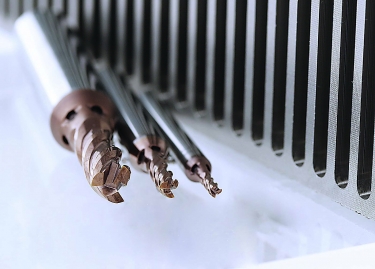In Lewis Carroll’s 1860s classic tale, near the start of her grand adventures in Wonderland, title character Alice found herself growing smaller and smaller after drinking a mysterious liquid.
Alice’s journey may have been the stuff of fantasy. But the goal of getting into smaller and smaller spaces has taken a very real step forward with the release of the CrazyMill Cool P&S by Switzerland-based cutting tool manufacturer Mikron Tool SA Agno.
The CrazyMill Cool P&S enables users to drill and mill into slots and pockets in extremely small spaces. The diameter range is from 0.39" to 0.236".
The tool, which is the latest product release in the CrazyMill line that Mikron introduced in 2009, is specifically designed to machine stainless steel, titanium, superalloys and chromium-cobalt alloys. In addition, it is suitable for cutting cast iron, nonferrous metals, steel up to 40 HRC and plastics.

The design of the CrazyMill Cool P&S enables one tool with a diameter as small as 1mm to combine vertical plunging, groove milling and finishing. Image courtesy of Mikron Tool
Users are able to combine drilling and milling in one tool. In that regard, it combines high-speed cutting with high-performance milling. For example, the tool can vertically drill up to 1 diameter deep and then move laterally for milling into solid material. This versatility makes the tool ideal for milling grooves and pockets, such as keyways (feather keys) found in drive shafts.
The bit’s head section gathers the chips while drilling, removing them sideways through the flutes. The geometry design stabilizes the drilling process and allows for vibration-free vertical plunging. Eliminating the
vibration also protects the integrity of the cutting edges.
The 3-flute CrazyMill Cool P&S integrates coolant supply ducts in the shank. The ducts, which number from three to five depending on the mill’s diameter, enable a constant coolant stream to flush chips from even the tiniest spaces while keeping the cutting edges from overheating. This process doubles tool life while leading to higher metal-removal rates, according to Hans Liechti, manager at Mikron Corp. Monroe.
The tools are made from an ultrafine-grain tungsten carbide that was developed especially for the tool. “Our goal was to have a carbide that was extremely tough and resistant to temperature changes,” he said.
Mikron’s creative team faced a couple of key challenges in developing the CrazyMill Cool P&S. “To begin with, we were combining the drilling and milling in one tool,” Liechti said. “As a result, we had to address not only heat-related issues but also wear-related issues.”
Part of the solution came from the high-performance eXedur SNP tool coating. “The coating provides resistance to the heat generated by the drilling; it also provides resistance to the wear generated by the milling,” he said.
“The eXedur SNP coating is particularly suitable for finishing operations,” Liechti added. “More specifically, it prevents material buildup and sticking at the cutting edges. At the same time, it helps with chip removal.”
For more information, contact Mikron Corp. Monroe, Monroe, Connecticut, by visiting www.mikrontool.com or calling (203) 261-3100.
Related Glossary Terms
- alloys
alloys
Substances having metallic properties and being composed of two or more chemical elements of which at least one is a metal.
- coolant
coolant
Fluid that reduces temperature buildup at the tool/workpiece interface during machining. Normally takes the form of a liquid such as soluble or chemical mixtures (semisynthetic, synthetic) but can be pressurized air or other gas. Because of water’s ability to absorb great quantities of heat, it is widely used as a coolant and vehicle for various cutting compounds, with the water-to-compound ratio varying with the machining task. See cutting fluid; semisynthetic cutting fluid; soluble-oil cutting fluid; synthetic cutting fluid.
- flutes
flutes
Grooves and spaces in the body of a tool that permit chip removal from, and cutting-fluid application to, the point of cut.
- gang cutting ( milling)
gang cutting ( milling)
Machining with several cutters mounted on a single arbor, generally for simultaneous cutting.
- milling
milling
Machining operation in which metal or other material is removed by applying power to a rotating cutter. In vertical milling, the cutting tool is mounted vertically on the spindle. In horizontal milling, the cutting tool is mounted horizontally, either directly on the spindle or on an arbor. Horizontal milling is further broken down into conventional milling, where the cutter rotates opposite the direction of feed, or “up” into the workpiece; and climb milling, where the cutter rotates in the direction of feed, or “down” into the workpiece. Milling operations include plane or surface milling, endmilling, facemilling, angle milling, form milling and profiling.
- milling machine ( mill)
milling machine ( mill)
Runs endmills and arbor-mounted milling cutters. Features include a head with a spindle that drives the cutters; a column, knee and table that provide motion in the three Cartesian axes; and a base that supports the components and houses the cutting-fluid pump and reservoir. The work is mounted on the table and fed into the rotating cutter or endmill to accomplish the milling steps; vertical milling machines also feed endmills into the work by means of a spindle-mounted quill. Models range from small manual machines to big bed-type and duplex mills. All take one of three basic forms: vertical, horizontal or convertible horizontal/vertical. Vertical machines may be knee-type (the table is mounted on a knee that can be elevated) or bed-type (the table is securely supported and only moves horizontally). In general, horizontal machines are bigger and more powerful, while vertical machines are lighter but more versatile and easier to set up and operate.
- shank
shank
Main body of a tool; the portion of a drill or similar end-held tool that fits into a collet, chuck or similar mounting device.
- superalloys
superalloys
Tough, difficult-to-machine alloys; includes Hastelloy, Inconel and Monel. Many are nickel-base metals.
- tungsten carbide ( WC)
tungsten carbide ( WC)
Intermetallic compound consisting of equal parts, by atomic weight, of tungsten and carbon. Sometimes tungsten carbide is used in reference to the cemented tungsten carbide material with cobalt added and/or with titanium carbide or tantalum carbide added. Thus, the tungsten carbide may be used to refer to pure tungsten carbide as well as co-bonded tungsten carbide, which may or may not contain added titanium carbide and/or tantalum carbide.


